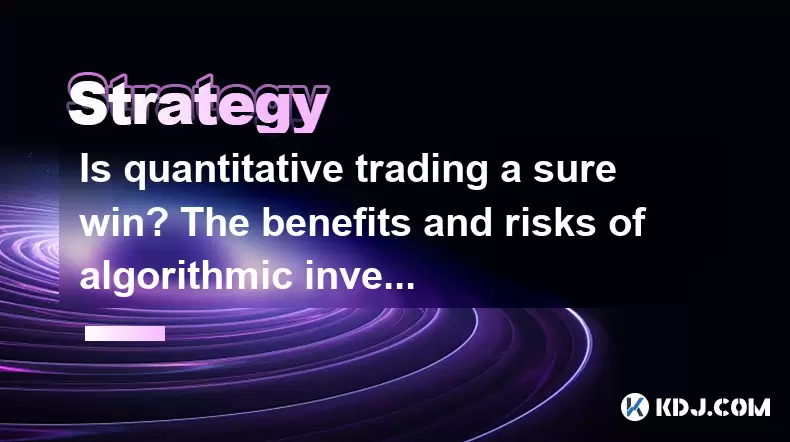-
 bitcoin
bitcoin $122025.899241 USD
-2.12% -
 ethereum
ethereum $4488.068729 USD
-4.11% -
 bnb
bnb $1315.348019 USD
8.65% -
 tether
tether $1.000457 USD
0.03% -
 xrp
xrp $2.875326 USD
-3.69% -
 solana
solana $222.043604 USD
-4.07% -
 usd-coin
usd-coin $0.999682 USD
0.00% -
 dogecoin
dogecoin $0.249887 USD
-5.62% -
 tron
tron $0.337379 USD
-2.59% -
 cardano
cardano $0.827763 USD
-5.06% -
 hyperliquid
hyperliquid $45.774531 USD
-2.43% -
 chainlink
chainlink $22.079309 USD
-5.87% -
 ethena-usde
ethena-usde $1.000156 USD
0.02% -
 sui
sui $3.482566 USD
-3.57% -
 stellar
stellar $0.386982 USD
-4.92%
Is quantitative trading a sure win? The benefits and risks of algorithmic investing
Quantitative trading in crypto offers data-driven decisions and backtesting but risks overfitting and tech failures in volatile markets.
Jun 01, 2025 at 07:00 pm

Is quantitative trading a sure win? The benefits and risks of algorithmic investing
Quantitative trading, also known as algorithmic trading, has become a popular method for investors seeking to leverage technology and data analysis to make informed decisions in the cryptocurrency market. The question of whether quantitative trading is a sure win is complex and multifaceted. To understand this, it's essential to delve into the benefits and risks associated with algorithmic investing in the crypto space.
Benefits of Quantitative Trading in the Cryptocurrency MarketQuantitative trading offers several advantages that can enhance trading strategies and potentially lead to profitable outcomes. One of the primary benefits is the ability to process vast amounts of data quickly and accurately. In the volatile world of cryptocurrencies, having access to real-time data and being able to analyze it swiftly can provide a significant edge.
Another advantage is the elimination of emotional bias. Human traders often fall prey to emotions such as fear and greed, which can lead to irrational decision-making. Algorithmic trading systems operate based on pre-defined rules and algorithms, ensuring that decisions are made based on data and logic rather than emotions.
Additionally, quantitative trading allows for backtesting. Traders can test their strategies against historical data to see how they would have performed in the past. This can help refine strategies and increase confidence in their potential success. In the crypto market, where historical data is readily available, backtesting can be particularly beneficial.
Risks Associated with Algorithmic Investing in CryptocurrenciesDespite its advantages, quantitative trading is not without risks. One of the primary risks is the potential for overfitting. Overfitting occurs when a trading model is too closely tailored to historical data, making it less effective in real-world scenarios. In the cryptocurrency market, where trends and patterns can change rapidly, overfitting can lead to significant losses.
Another risk is the reliance on technology. While algorithmic systems can process data quickly, they are also susceptible to technical failures. A glitch in the system or a connectivity issue can result in missed opportunities or unintended trades. In the fast-paced crypto market, these issues can have serious consequences.
Moreover, the crypto market is known for its high volatility. While this can present opportunities for profit, it also increases the risk of significant losses. Algorithmic trading strategies that perform well in stable markets may struggle in highly volatile conditions, leading to unexpected outcomes.
Understanding the Mechanics of Quantitative Trading in CryptoTo fully grasp the potential and limitations of quantitative trading in the cryptocurrency market, it's important to understand how these systems work. At its core, quantitative trading involves the use of mathematical models and algorithms to make trading decisions.
Data Collection: The first step in quantitative trading is gathering data. This includes price data, trading volume, market sentiment, and other relevant metrics. In the crypto market, data can be sourced from exchanges, blockchain explorers, and other platforms.
Data Analysis: Once the data is collected, it needs to be analyzed. This involves using statistical methods and machine learning algorithms to identify patterns and trends. In the crypto space, where data is abundant, this step is crucial for developing effective trading strategies.
Strategy Development: Based on the analysis, traders develop strategies that can be implemented through algorithms. These strategies can range from simple moving average crossovers to complex machine learning models. The key is to create strategies that are robust and adaptable to the dynamic nature of the crypto market.
Execution: The final step is executing the trades based on the developed strategies. This is where the speed and accuracy of algorithmic systems come into play. In the crypto market, where prices can change rapidly, quick execution is essential.
To illustrate the practical application of quantitative trading in the cryptocurrency market, consider the following examples:
Arbitrage Trading: One common strategy is arbitrage trading, where traders take advantage of price differences between different exchanges. An algorithm can monitor prices across multiple platforms and execute trades to profit from these discrepancies. In the crypto market, where price differences can be significant, arbitrage can be highly profitable.
Trend Following: Another popular strategy is trend following, where traders use algorithms to identify and follow market trends. In the crypto market, where trends can be strong and sustained, trend-following strategies can lead to substantial gains. However, they also carry the risk of significant losses if the trend reverses unexpectedly.
Mean Reversion: Mean reversion strategies are based on the idea that prices will eventually return to their average. In the crypto market, where prices can deviate significantly from their mean, mean reversion strategies can be effective. However, they require careful monitoring and adjustment to account for the market's volatility.
The question of whether quantitative trading is a sure win in the cryptocurrency market is not straightforward. While there are numerous success stories, there are also instances of significant losses. The success rate of quantitative trading depends on various factors, including the quality of the data, the robustness of the algorithms, and the trader's ability to adapt to changing market conditions.
In the crypto market, where volatility is high and trends can change rapidly, even the most sophisticated algorithms can struggle. However, with careful strategy development, rigorous backtesting, and continuous monitoring, quantitative trading can be a powerful tool for achieving consistent profits.
The Role of Risk Management in Algorithmic InvestingEffective risk management is crucial for the success of quantitative trading in the cryptocurrency market. Traders need to implement strategies to mitigate potential losses and protect their capital. Some key risk management techniques include:
Position Sizing: Determining the appropriate size of each trade based on the trader's risk tolerance and the volatility of the market. In the crypto market, where price swings can be extreme, careful position sizing is essential.
Stop-Loss Orders: Setting stop-loss orders to limit potential losses. These orders automatically sell a position if the price falls below a certain level, helping to prevent significant losses in the volatile crypto market.
Diversification: Spreading investments across different cryptocurrencies and strategies to reduce risk. In the crypto market, where individual assets can be highly volatile, diversification can help balance potential gains and losses.
Continuous Monitoring: Regularly reviewing and adjusting trading strategies to adapt to changing market conditions. In the dynamic crypto market, staying vigilant and making timely adjustments can be the difference between success and failure.
- Can anyone start quantitative trading in the cryptocurrency market?
Yes, anyone with the necessary knowledge and resources can start quantitative trading in the crypto market. However, it requires a solid understanding of data analysis, programming, and trading strategies. Additionally, access to reliable data sources and trading platforms is essential.
- What are the most important factors to consider when developing a quantitative trading strategy for cryptocurrencies?
The most important factors include the quality and relevance of the data, the robustness and adaptability of the algorithms, and the trader's ability to manage risk effectively. In the crypto market, where conditions can change rapidly, these factors are crucial for developing successful strategies.
- How can traders avoid common pitfalls in quantitative trading in the crypto market?
To avoid common pitfalls, traders should focus on avoiding overfitting, ensuring the reliability of their technology, and adapting their strategies to the market's volatility. Regular backtesting, continuous monitoring, and effective risk management can help mitigate these risks.
- Is it possible to achieve consistent profits through quantitative trading in the cryptocurrency market?
While consistent profits are possible, they are not guaranteed. Success in quantitative trading depends on various factors, including the quality of the strategies, the effectiveness of risk management, and the trader's ability to adapt to changing market conditions. In the crypto market, where volatility is high, achieving consistent profits requires diligence and adaptability.
Disclaimer:info@kdj.com
The information provided is not trading advice. kdj.com does not assume any responsibility for any investments made based on the information provided in this article. Cryptocurrencies are highly volatile and it is highly recommended that you invest with caution after thorough research!
If you believe that the content used on this website infringes your copyright, please contact us immediately (info@kdj.com) and we will delete it promptly.
- BlockDAG, DOGE, HYPE Sponsorship: Crypto Trends Shaping 2025
- 2025-10-01 00:25:13
- Deutsche Börse and Circle: A StableCoin Adoption Powerhouse in Europe
- 2025-10-01 00:25:13
- BlockDAG's Presale Buzz: Is It the Crypto to Watch in October 2025?
- 2025-10-01 00:30:13
- Bitcoin, Crypto, and IQ: When Genius Meets Digital Gold?
- 2025-10-01 00:30:13
- Stablecoins, American Innovation, and Wallet Tokens: The Next Frontier
- 2025-10-01 00:35:12
- NBU, Coins, and Crypto in Ukraine: A New Yorker's Take
- 2025-10-01 00:45:14
Related knowledge

Practical parameter settings for a Bitcoin multi-timeframe moving average system
Sep 18,2025 at 10:54pm
Optimizing Timeframe Combinations for Bitcoin Trading1. Selecting appropriate timeframes is crucial when building a multi-timeframe moving average sys...

How can I filter out false breakouts in Dogecoin high-frequency trading?
Sep 22,2025 at 01:00am
Understanding False Breakouts in Dogecoin Trading1. A false breakout occurs when Dogecoin's price appears to move beyond a defined support or resistan...

Techniques for identifying tops and bottoms in the Bitcoin on-chain NVT model
Sep 20,2025 at 07:54pm
Understanding the NVT Model in Bitcoin Analysis1. The Network Value to Transactions (NVT) ratio is often described as the 'P/E ratio' of the cryptocur...

What does the surge in open interest in Bitcoincoin futures mean?
Sep 20,2025 at 11:18pm
Understanding the Surge in Dogecoin Futures Open Interest1. A surge in open interest within Dogecoin futures indicates a growing number of active cont...

How can I use the Ethereum USDT premium to gauge market sentiment?
Sep 18,2025 at 11:55pm
Understanding the Ethereum USDT Premium1. The Ethereum USDT premium refers to the price difference between USDT (Tether) traded on Ethereum-based plat...

What should I do if Ethereum staking yields decline?
Sep 20,2025 at 06:18am
Understanding the Causes Behind Declining Ethereum Staking Yields1. The Ethereum network transitioned to a proof-of-stake consensus mechanism with the...

Practical parameter settings for a Bitcoin multi-timeframe moving average system
Sep 18,2025 at 10:54pm
Optimizing Timeframe Combinations for Bitcoin Trading1. Selecting appropriate timeframes is crucial when building a multi-timeframe moving average sys...

How can I filter out false breakouts in Dogecoin high-frequency trading?
Sep 22,2025 at 01:00am
Understanding False Breakouts in Dogecoin Trading1. A false breakout occurs when Dogecoin's price appears to move beyond a defined support or resistan...

Techniques for identifying tops and bottoms in the Bitcoin on-chain NVT model
Sep 20,2025 at 07:54pm
Understanding the NVT Model in Bitcoin Analysis1. The Network Value to Transactions (NVT) ratio is often described as the 'P/E ratio' of the cryptocur...

What does the surge in open interest in Bitcoincoin futures mean?
Sep 20,2025 at 11:18pm
Understanding the Surge in Dogecoin Futures Open Interest1. A surge in open interest within Dogecoin futures indicates a growing number of active cont...

How can I use the Ethereum USDT premium to gauge market sentiment?
Sep 18,2025 at 11:55pm
Understanding the Ethereum USDT Premium1. The Ethereum USDT premium refers to the price difference between USDT (Tether) traded on Ethereum-based plat...

What should I do if Ethereum staking yields decline?
Sep 20,2025 at 06:18am
Understanding the Causes Behind Declining Ethereum Staking Yields1. The Ethereum network transitioned to a proof-of-stake consensus mechanism with the...
See all articles










































































